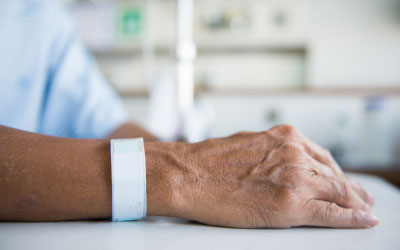Large Granular Lymphocytic Leukemia
Large granular lymphocytic leukemia (LGLL) is a chronic blood and bone marrow cancer. It mostly affects adults over 60 years old and rarely affects children. Most patients survive ten years or longer with treatment.
What is large granular lymphocytic leukemia (LGLL)?
Large granular lymphocytic leukemia (LGLL) affects mature white blood cells called lymphocytes. “Cyte” means cell. “Lympho-” means these cells travel within the lymphatic system. The lymphatic system is a part of your body’s immune system that fights infection.
The bone marrow (soft inner part of the bones) produces lymphocytes called T-cells and natural killer cells. T-cells and natural killer cells are large. The fluid inside these cells (cytoplasm) appears “granular” (like grains of sand) under a microscope.
T-cells and natural killer cells live longer than they should in LGLL, becoming cancerous. They may spread through the lymphatic system to the spleen, liver, or lymph nodes.
LGLL often occurs along with autoimmune disorders, especially rheumatoid arthritis. Autoimmune disorders are conditions where the immune system attacks healthy cells in the body.
large granular lymphocytic leukemia facts and stats
- LGLL accounts for between 2-5% of chronic leukemias.
- Less than 25% of patients are younger than 50 years.
- Median age at diagnosis is 60 years.
- Autoimmune disorders occur before LGLL diagnosis in 20% of cases.
- Spleen enlargement occurs in 25-50% of LGLL cases.
- Around 70% of people treated for LGLL survive after ten years.
Causes and risk factors of large granular lymphocytic leukemia
The cause of LGLL is unknown. Researchers think that LGLL develops following viral infections. White blood cells, such as T-cells and natural killer cells, fight off the virus. Exposure to the virus may cause genetic mutations (changes) in these cells, contributing to LGLL development.
Risk factors include:
- Asian or South American ancestry (more likely to develop aggressive NK-LGLL)
- Autoimmune disorders (rheumatoid arthritis, Sjogren syndrome, lupus, and Hashimoto’s thyroiditis)
Signs and symptoms of large granular lymphocytic leukemia
Signs and symptoms of LGLL may include:
- Anemia (low red blood cell count)
- Easy bruising
- Enlarged spleen
- Fatigue
- Recurrent fevers/frequent infections/night sweats
- Swelling of lymph nodes (rare)
- Unexplained weight loss
Types of large granular lymphocytic leukemia
There are two types of large granular lymphocytic leukemia. Either type can be either aggressive (fast-growing) or indolent (slow-growing).
The two types are:
- Natural killer cell large granular lymphocytic leukemia (NK-LGLL) (10-15% of LGLL cases)
- T-cell large granular lymphocytic leukemia (T-LGLL) (85% of LGLL cases)
The aggressive form of NK-LGLL is usually associated with the Epstein-Barr virus and can be harder to treat. Most T-LGLL cases progress slowly.
Diagnosing large granular lymphocytic leukemia
Your doctor performs a physical exam and asks about your medical history to diagnose LGLL.
Tests may include:
- Complete blood cell (CBC) count: These tests measure the number of white blood cells, red blood cells, and platelets in a blood sample. A high number of white blood cells and a low number of red blood cells and/or platelets may point to LGLL.
- Flow cytometry: This test distinguishes between LGLL subtypes by determining if the LGLL cells are T-cells or NK cells.
- T-cell gene rearrangement: This genetic test shows that a group of T-cells with the same features came from the same parent cell (clonality).
- Bone marrow aspiration or biopsy: Your doctor uses a thin, hollow needle to remove small samples of bone marrow or bone tissue for analysis. This is usually not required to diagnose LGLL but may rule out other conditions.
- Imaging: Imaging locates affected lymph nodes and tumors. It helps to measure the size of enlarged organs, such as the liver or spleen. Imaging may include:
- Computed tomography (CT) scans
- Magnetic resonance imaging (MRI) scans
- Ultrasounds (US)
Treatments for large granular lymphocytic leukemia
Treatment depends on your LGLL subtype, current symptoms, response to treatment, and general health.
Treatments for LGLL include:
- Watch and wait: Your doctor watches your condition without starting treatment right away. Treatment begins when symptoms appear. This method delays or avoids harmful treatment-related side effects.
- Chemotherapy: Chemotherapy drugs slow the growth of cancer cells or kill them. You receive them as pills or injections into a vein, muscle, or underneath the skin.
- Immunosuppressants: . Doctors may prescribe these drugs to those with comorbid autoimmune disorders and LGLL to stop the immune system from attacking healthy cells.
- Stem cell transplant (bone marrow transplant): Healthy stem cells (blood-forming cells in the bone marrow) replace unhealthy stem cells. Healthy stem cells most often come from a donor but may also come from your own healthy cells.
- Clinical trials: Researchers test and develop new drug treatments through clinical trials. Eligible patients can gain access to these promising treatments if they take part in these trials. These treatments are usually not available to the public since they are under development.
- Supportive therapies: These therapies may replace or support intensive therapies, such as chemotherapy. They can provide relief from cancer symptoms or treatment-related side effects. Supportive therapies may include:
- Antibiotics to treat recurrent infections
- Blood transfusions to treat low platelet and red blood cell levels
- Counseling
- Diet
- Pain management
- Physical exercise
- Relaxation exercises and meditation
Helpful resources
Support can make a significant difference when you face a cancer diagnosis. You can connect with others who understand these challenges through our peer support programs. We offer an online support community and a mentoring program. We also have a directory of resources to help patients, families, and caregivers.



